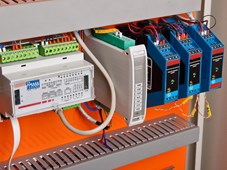“Rugged is right”: Why industrial HMI is tougher than most
By Mike Bolduc | October 15, 2018

While we concentrate on features and capabilities when selecting products – at home, work or elsewhere – once the purchase is made, our opinion of the product is based on our interaction with it. This means that the human-machine interface (HMI) is important – not only for operating the equipment, but also for determining how users feel about the equipment and whether they are likely to purchase it again – or recommend it to others.
In the high-tech sector, manufacturers of devices such as smartphones and tablets recognized this some time ago, and spend huge amounts of time and money developing ever more sophisticated, yet intuitive HMIs for their latest devices. In these data- and graphic-focused devices, the HMI is very much centered around the display allowing menus and options to be changed contextually as required to suit the task in hand, with users selecting the relevant option with a gentle finger press.
Moving forward, greater convenience can be delivered if manual pressing is eliminated entirely. Humans are essentially audio driven, and in our normal lives we speak to other humans and hear their response. The high-tech sector is starting to latch on to this with devices such as AI-based assistants, smartphones and even miniature in-ear “hearable” devices responding to, and responding by, audio.
However, if you walk into a typical industrial setting, few if any machines, instruments or other pieces of equipment have touch-screen or audio-driven HMIs. This is not to say that the equipment is old, or that the industrial sector is lagging behind – far from it. What it is saying is that these modern touch screens or voice-driven HMIs are simply not suitable for environments where many operators wear protective gloves and there is generally a lot of noise present.
Take, for example, an industrial welder. In the middle of a job, they may need to adjust the welding current – but taking off their gloves to pick through menus on a touch screen is a nuisance, not a benefit. Here a simple rotary knob that has positive steps and can be operated while still wearing gloves is far more convenient – and appropriate for the situation.
Electromechanical front-panel switches have many benefits in an industrial situation. Apart from being strong and easily operated by people wearing gloves, they are also robust and unlikely to be damaged by operators who are often “heavy-handed.” And, should a switch be damaged, it is cheaper and easier to replace than a sophisticated touch-sensitive display.
Operators can see the status of a machine simply by looking across a workshop and seeing switch positions – there is no need to walk across and wake up a display that has gone into power-saving sleep mode to tell what the settings are.
Emergencies are another area where large, robust, physical buttons are preferred. Can you imagine trying to shout at a machine where a colleague is trapped just to turn it off – especially if you don’t know the exact phrase, or your regional accent is not recognized? The big red button works every time.
As one of the world’s leading switch suppliers, C&K makes switches for all types of industrial (and other) applications. C&K offers over 55,000 standard products and 8.5 million switch combinations, including many that are used in industrial applications. C&K products include tactile, pushbutton, snap-acting, toggle, rocker, detect, DIP, keyswitch, navigation, rotary, slide, switchlock, thumbwheel, smart card readers, high-rel connectors and custom assemblies – and many of these can be customized to suit your industrial application.

Mike Bolduc
Global Segment Manager
Industrial
